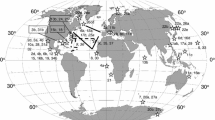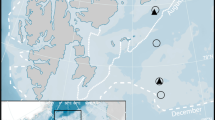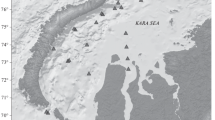Abstract
Oxygen uptake and ammonia excretion rates, and body carbon and nitrogen contents were measured in krill (Euphausia superba) and eight other zooplankton species collected during November–December 1982 in the Prydz Bay, Antarctica. From these data, metabolic O:N ratios (by atoms), body C:N ratios (by weight) and daily metabolic losses of body carbon and nitrogen were calculated as a basis from which to evaluate seasonal differences in metabolism and nutritional condition. Comparison of the present data with mid-summer (January) data revealed that early-summer E. superba were characterized by higher metabolic O:N ratios (58.7 to 103, compared with 15.9 to 17.5 for mid-summer individuals). Higher O:N ratios of early-summer E. superba resulted largely from reduced ammonia excretion rates and, to a lesser degree, from slightly increased oxygen uptake rates. Body C:N ratios of E. superba were low in early-summer (3.8 to 4.2) compared with mid-summer krill (4.1 to 4.7) due to lowered body-carbon contents in the former (42.6 to 43.6% compared with 43.2 to 47.5% dry weight of midsummer individuals); gravid females formed an exception, since no seasonal differences in body elemental composition were detected for these. No significant changes in water content (75.3 to 81.4% wet wt) and nitrogen content (9.9 to 11.1% dry wt) in E. superba were evident between the two seasons. Seasonal differences in metabolic rates and elemental composition were less pronounced in a salp (Salpa thompsoni), but a higher metabolic O:N ratio occurred in early-summer individuals. Interspecific comparison of the seven remaining zooplankton species studied with twelve species from mid-summer zooplankton investigated in an earlier study indicated that higher metabolic O:N ratios in early-summer are characteristic not only of herbivore/filter-feeders, but also of some carnivores/omnivores. No relationship between metabolic O:N ratios and body C:N ratios was apparent either intraspecifically or interspecifically, within or between early-summer and mid-summer seasons.
Similar content being viewed by others
Literature cited
Antezana, T., K. Ray and C. Melo: Trophic behavior of Euphausia superba Dana in laboratory conditions. Polar Biol. 1, 77–82 (1982)
Båmstedt, U.: Studies on the deep-sea pelagic community of Korsfjorden, Western Norway. Seasonal variation in weight and biochemical composition of Chiridius armatus (Copepoda), Boreomysis arctica (Mysidacea) and Eukrohnia hamata (Chaetognatha) in relation to their biology. Sarsia 63, 145–153 (1978)
Bargmann, E. E.: The development and life-history of adolescent and adult krill, Euphausia superba. ‘Discovery’ Rep. 23, 103–176 (1945)
Biggs, D. C.: Zooplankton excretion and NH +4 cycling in nearsurface waters of the Southern Ocean. I. Ross Sea, austral summer 1977–1978. Polar Biol. 1, 55–67 (1982)
Butler, E. I., E. D. S. Corner and S. M. Marshall: On the nutrition and metabolism of zooplankton. VII. Seasonal survey of nitrogen and phosphorus excretion by Calanus in the Clyde Sea-area. J. mar. biol. Ass. U.K. 50, 525–560 (1970)
Clarke, M. R.: A new midwater trawl for sampling discrete depth horizons. J. mar. biol. Ass. U.K. 49, 945–960 (1969)
Clarke, A.: Lipid content and composition of Antarctic krill, Euphausia superba Dana. J. Crustacean Biol. (Lawrence, Kansas) 4 (Spec. No. 1), 285–294 (1984)
Conover, R. J. and E. D. S. Corner: Respiration and nitrogen excretion by some marine zooplankton in relation to their life cycles. J. mar. biol. Ass. U.K. 48, 49–75 (1968)
Corner, E. D. S. and A. G. Davies: Plankton as a factor in the nitrogen and phosphorus cycles in the sea. Adv. mar. Biol. 9, 101–204 (1971)
Ehrlich, K. F.: Chemical changes during growth and starvation of herring larvae. In: The early life history of fish, pp 301–323. Ed. by J. H. S. Blaxter. New York, Heidelberg and Berlin: Springer-Verlag 1974
Foxton, P.: The distribution and life-history of Salpa thompsoni Foxton with observations on a related species, Salpa gerlachei Foxton. ‘Discovery’ Rep. 34, 3–115 (1966)
Gnaiger, E.: Calculation of energetic and biochemical equivalents of respiratory oxygen consumption. In: Polarographic oxygen sensors, pp 337–345. Ed by E. Gnaiger and H. Horstner. Berlin: Springer-Verlag 1983
Heron, A. C.: Population ecology of a colonizing species: the pelagic tunicate Thalia democratica. I. Individual growth rate and generation time. Oecologia Berl.) 10, 269–293 (1972)
Hiller-Adams, P. and J. J. Childress. Effects of prolonged starvation on O2 consumption, NH +4 excretion, and chemical composition of the bathypelagic mysid Gnathophausia ingens. Mar. Biol. 77, 119–127 (1983)
Hirshe, H.-J.: Excretion and respiration of the Antarctic krill Euphausia superba. Polar Biol. 1, 205–209 (1983)
Ikeda, T.: Metabolic rates of epipelagic marine zooplankton as a function of body mass and temperature. Mar. Biol. 85, 1–11 (1985)
Ikeda, T. and P. Dixon: Body shrinkage as a possible overwintering mechanism of the Antarctic krill, Euphausia superba Dana. J. exp. mar. Biol. Ecol. 62, 143–151 (1982)
Ikeda, T. and A. W. Mitchell: Oxygen uptake, ammonia excretion and phosphate excretion by krill and other Antarctic zooplankton in relation to their body size and chemical composition. Mar. Biol. 71, 283–298 (1982)
Knox, G. A.: Antarctic marine ecosystems. In: Antarctic ecology 1, pp 69–96. Ed by M. W. Holdgate. London and New York: Academic Press 1970
Love, R. M.: The chemical biology of fishes, 547 pp. London and New York: Academic Press 1970
Marshall, S. M. and A. P. Orr: The biology of a marine copepod Calanus finmarchicus (Gunnerus), 188 pp. Edinburgh and London: Oliver & Boyd 1955
Nemoto, T. and G. Harrison: High latitude ecosystems. In: Analysis of marine ecosystems, pp 95–126. Ed. by A. R. Longhurst. London: Academic Press 1981
Omori, M. and T. Ikeda: Methods in marine zooplankton ecology, 332 pp. New York: John Wiley & Sons 1984
Rakusa-Suszczewski, S. and K. W. Opalinski: Oxygen consumption in Euphausia superba. Polskie Archwm Hydrobiol. 25, 633–641 (1978)
Segawa, S., M. Kato and M. Murano: Respiration and ammonia excretion rates of the Antarctic krill, Euphausia superba Dana. Trans. Tokyo Univ. Fish. 5, 177–187 (1982)
Snedecor, G. W. and W. G. Cochran: Statistical methods, 6th ed. 593 pp. Ames, Iowa: Iowa State University Press 1967
Streten, N. A. and D. J. Pike: Some observations of the sea-ice in the Southwest Indian Ocean. Aust. met. Mag. (Melbourne) 32, 195–206 (1984)
Strickland, J. D. H. and T. R. Parsons: A practical handbook of seawater analysis, 2nd ed. Bull. Fish. Res. Bd Can. 167, 1–310 (1972)
Author information
Authors and Affiliations
Additional information
Communicated by G. F. Humphrey, Sydney
Rights and permissions
About this article
Cite this article
Ikeda, T., Bruce, B. Metabolic activity and elemental composition of krill and other zooplankton from Prydz Bay, Antarctica, during early summer (November–December). Mar. Biol. 92, 545–555 (1986). https://doi.org/10.1007/BF00392514
Accepted:
Issue Date:
DOI: https://doi.org/10.1007/BF00392514




